How Fast Is Europe Getting Old? Analysis of Dynamics Applying the Spatial Shift–Share Approach
Abstract
1. Introduction
2. Population Aging in Literature
3. Data and Methodology
3.1. Preliminary Data Analysis
3.2. Spatial Dynamic Shift–Share Analysis
3.3. Spatial Matrix—Reasoning and Selection
4. Results and Discussion
4.1. Interpretation of SSSA Components
4.2. Discussion of Potential Determinants of SSSA Results
- The labor force participation of older people is high and rising;
- Most older people are active in civic organizations, volunteering, family activities, and have regular social contact;
- Norwegian health policy is designed to emphasize individual empowerment and coping skills;
- That same health policy emphasizes health promotion and disease prevention, tailored to all life stages;
- Public health policy stresses active aging.
- Increasing social awareness of the benefits of involvement of and involving older people in community activities;
- Addressing barriers to involvement, particularly for older people who are not able to live independently or who are frail;
- Considering the needs and desires of an older population for involvement;
- Providing opportunities and increasing motivation to participate.
5. Conclusions
Author Contributions
Funding
Conflicts of Interest
Appendix A
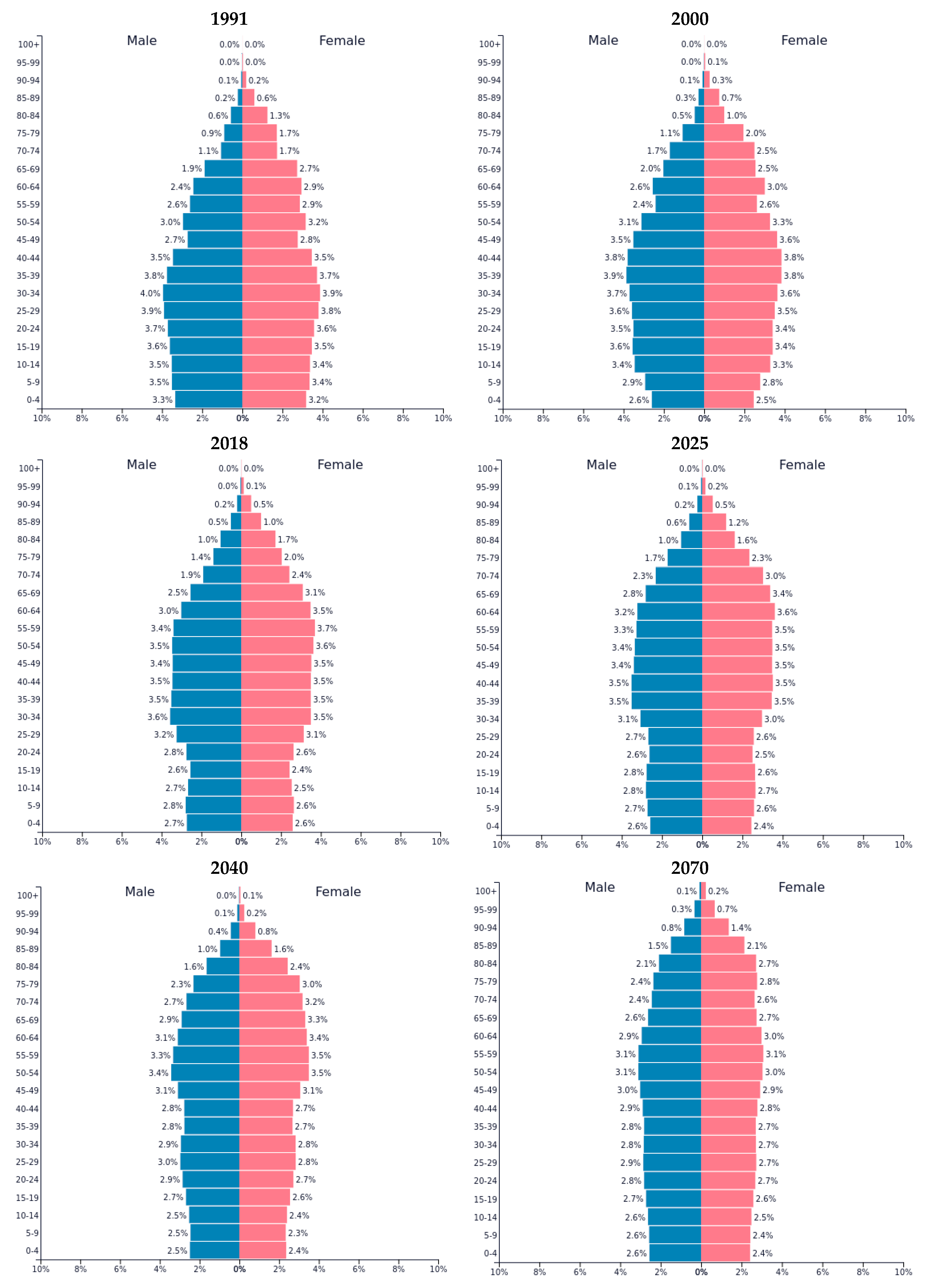
References
- United Nations. World Population Ageing 2017. Available online: https://www.un.org/en/development/desa/population/publications/pdf/ageing/WPA2017_Highlights.pdf (accessed on 3 October 2019).
- World Bank. Available online: https://data.worldbank.org/indicator/SP.POP.65UP.TO.ZS (accessed on 3 October 2019).
- Eurostat. Population on 1 January by Broad Age Group and Sex. Available online: http://appsso.eurostat.ec.europa.eu/nui/show.do?dataset=demo_pjanbroad&lang=en (accessed on 28 June 2019).
- European Commission. The 2018 Ageing Report. Underlying Assumptions and Projection Methodologies; Institutional Paper 065; European Union: Brussels, Belgium, 2017. [Google Scholar] [CrossRef]
- World Health Organization. Healthy Ageing and the Sustainable Development Goals. Available online: https://www.who.int/ageing/sdgs/en/ (accessed on 1 July 2019).
- Monnier, A. Baby boomers: Towards the end of an era. Popul. Soc. 2007, 431, 1. [Google Scholar]
- Costa, D.L. Causes of improving health and longevity at older ages: A review of the explanations. Genus 2005, 61. [Google Scholar] [CrossRef]
- World Health Organization. Global Health and Ageing. Available online: https://www.who.int/ageing/publications/global_health.pdf (accessed on 9 July 2019).
- ESHRE Capri Workshop Group. Europe the continent with the lowest fertility. Hum. Reprod. Update 2010, 16, 590–602. [Google Scholar]
- Carone, G.; Costello, D. Can Europe Afford to Grow Old? Financ. Dev. 2006, 43, 28–31. [Google Scholar]
- Begg, I.; Brinke, L. Coming to Terms with an Ageing Europe. Dahrendorf Forum Policy Brief 2018. Available online: https://www.dahrendorf-forum.eu/publications/coming-to-terms-with-an-ageing-europe/ (accessed on 10 July 2019).
- Walker, A. The Future of Ageing in Europe. Making an Asset of Longevity; Department of Sociological Studies, University of Sheffield: Sheffield, UK, 2019. [Google Scholar] [CrossRef]
- European Commission. The 2015 Ageing Report. Economic and budgetary projections for the 28 EU Member States (2013–2060). Eur. Econ. 2015, 3. [Google Scholar] [CrossRef]
- Gløersen, E.; Drăgulin, M.; Hans, S.; Kaucic, J.; Schuh, B.; Keringer, F.; Celotti, P. The Impact of Demographic Change on European Regions; European Union: Brussels, Belgium, 2016. [Google Scholar] [CrossRef]
- Perry, M.; Hayward, D. Contribution of Demographic Structure to Regional Migration, 1991–2001. N. Z. Popul. Rev. 2003, 29, 139–146. [Google Scholar]
- Jones, P. Job creation and regional change under New Labour: A shift-share analysis. Environ. Plan. 2012, 44. [Google Scholar] [CrossRef]
- Davis, S.M.; Rodriguez, A.E. Something Old, Something New: MBA Program Evaluation Using Shift-Share Analysis and Google Trends. Res. High. Educ. J. 2004, 23, 1–15. [Google Scholar]
- Albuquerque, P.; Ferreira, J. Envelhecimento, emprego e remunerações nas regiões portuguesas: Uma análise shift-share. EURE 2015, 41, 239–260. [Google Scholar] [CrossRef]
- Antczak, E.; Lewandowska-Gwarda, K. Dynamics of population ageing process in Poland. The analysis using structural-geographic methods. Studia Studia Reg. I Lokalne 2018, 4, 89–110. [Google Scholar] [CrossRef]
- Creamer, D. Shift of Manufacturing Industries. In Industrial Location and National Resources; U.S. Government Printing Office: Washington, DC, USA, 1942; Volume 9, pp. 85–104. [Google Scholar]
- Dunn, E.S. A statistical and analytical technique for regional analysis. Pap. Reg. Sci. Assoc. 1960, 6, 77–112. [Google Scholar] [CrossRef]
- Barff, R.A.; Knight, P.L. Dynamic Shift-Share Analysis. J. Urban Reg. Policy 1988, 19, 1–10. [Google Scholar] [CrossRef]
- Tobler, W. A Computer Movie Simulating Urban Growth in the Detroit Region. Econ. Geogr. 1970, 46, 234–240. [Google Scholar] [CrossRef]
- Nazara, S.; Hewings, G.J.D. Spatial Structure and Taxonomy of Decomposition in Shift-Share Analysis. Growth Chang. 2004, 35, 476–490. [Google Scholar] [CrossRef]
- Griffith, D.A. Some Guidelines for Specifying the Geographic Weights Matrix. In Practical Handbook of Spatial Statistics; Arlinhaus, S.L., Ed.; CRC: Boca Raton, FL, USA, 1996; pp. 65–82. [Google Scholar]
- Zhang, X.; Yu, J. Spatial weights matrix selection and model averaging for spatial autoregressive models. J. Econ. 2018, 203, 1–18. [Google Scholar] [CrossRef]
- Getis, A.; Aldstadt, J. Constructing the Spatial Weights Matrix Using a Local Statistic Spatial. Geogr. Anal. 2004, 36, 90–104. [Google Scholar] [CrossRef]
- LeSage, J.; Pace, R. Introduction to Spatial Econometrics; Chapman and Hall/CRC: New York, NY, USA, 2009. [Google Scholar] [CrossRef]
- Wulff, J.; Ejlskov, L. Multiple Imputation by Chained Equations in Praxis: Guidelines and Review. Electron. J. Bus. Res. Methods 2017, 15, 41–55. [Google Scholar]
- Suchecka, J.; Urbaniak, B. Determinants of Healthy Ageing for Older People in European Countries—A Spatio-Temporal Approach. Comp. Econ. Res. 2016, 19, 157–178. [Google Scholar] [CrossRef]
- Sundström, G.; Fransson, E.; Malmberg, B.; Davey, A. Loneliness among older Europeans. Eur. J. Ageing 2009, 6, 267. [Google Scholar] [CrossRef]
- Wiktorowicz, J. Age Management—A Remedy for Population Ageing? Eur. Spat. Res. Policy 2013, 20, 157–168. [Google Scholar] [CrossRef]
- Herrera, M.; Mur, J.; Ruiz, M. A Comparison Study on Criteria to Select the Most Adequate Weighting Matrix. Entropy 2019, 21, 160. [Google Scholar] [CrossRef]
- Lagergren, M.; Johnell, K.; Schon, P.; Danielsson, M. Towards a postponement of activities of daily living dependence and mobility limitations: Trends in healthy life years in old age in Sweden. Scand. J. Public Health 2017, 45, 520–527. [Google Scholar] [CrossRef] [PubMed]
- Royal Norwegian Ministry of Labour and Social Affairs November. UNECE National Report on Ageing 2016—NORWAY Follow-up to the Regional Implementation Strategy (RIS) of the Madrid International Action Plan on Ageing (MIPAA). 2016. Available online: https://www.unece.org/fileadmin/DAM/pau/age/country_rpts/2017/NOR_report.pdf (accessed on 10 July 2019).
- UN. Norway’s Follow-up of Agenda 2030 and the Sustainable Development Goals. New York. July 2016. Available online: https://www.regjeringen.no/en/dokumenter/follow-up-sdg2/id2507259/ (accessed on 10 July 2019).
- Modig, K.; Virtanen, S.; Ahlbom, A.; Agahi, N. Stable or improved health status in the population 65 years and older in Stockholm, Sweden—An 8-year follow-up of self-reported health items. Scand. J. Public Health 2016, 44, 480–489. [Google Scholar] [CrossRef] [PubMed]
- Crimmins, E.M.; Beltran-Sanchez, H. Mortality and morbidity trends: Is there compression of morbidity? J. Gerontol. B Psychol. Sci. Soc. Sci. 2011, 66, 75–86. [Google Scholar] [CrossRef] [PubMed]
- Institute of Public Health. Health among the elderly in Norway. Public Health Report—Health Status in Norway; Institute of Public Health: Oslo, Norway, 2017; Available online: https://www.fhi.no/en/op/hin/groups/health-and-ageing-in-norway/ (accessed on 10 September 2019).
- Luxembourg Institute of Socio-Economic Research. Available online: https://www.liser.lu/ise/display_indic.cfm?id=338 (accessed on 10 September 2019).
- Koch, A.; Weisgerber, C. Facts about Elderly People and Long-Term Care in Luxembourg. Available online: https://ec.europa.eu/social/BlobServlet?docId=8228&langId=en (accessed on 10 September 2019).
- Luxembourg Institute of Socio-Economic Research. Urban Development and Mobility. Available online: https://www.liser.lu/?type=module&id=104&tmp=4322 (accessed on 10 September 2019).
- OECD; European Observatory on Health Systems and Policies. State of Health in the EU; Luxembourg. Country Health Profile 2017; Paris/European Observatory on Health Systems and Policies: Brussels, Belgium, 2017; Available online: http://www.euro.who.int/__data/assets/pdf_file/0011/355988/Health-Profile-Luxembourg-Eng.pdf?ua=1 (accessed on 10 September 2019).
- Formosa, M. Population Trends and Ageing Policy in Malta. Soc. Sci. 2013, 2, 90–96. [Google Scholar] [CrossRef]
- Decelis, A.A. A Critical Review of Malta’s Rising Ageing Population. Available online: https://timesofmalta.com/articles/view/A-critical-review-of-Malta-s-rising-ageing-population.487857 (accessed on 10 September 2019).
- Jurek, K.; Dobrowolska, B. Older people, ageing and old age in the light of some public opinion surveys in Poland. Rocznik Nauk Społecznych 2017, 9, 7–25. [Google Scholar] [CrossRef][Green Version]
- Baranowska, A. Starzenie się społeczeństwa europejskiego jako wyzwanie XXI wieku. Casus Polski. Opusc. Sociol. 2017, 4, 55–66. [Google Scholar] [CrossRef]
- Walkenhorst, P.; Sila, U. The economic consequences of an ageing population in Slovenia. In OECD Economics Department Working Papers; OECD Publishing: Paris, France, 2015. [Google Scholar] [CrossRef]
- Hlebec, V.; Rakar, T. Ageing Policies in Slovenia: Before and After “Austerity”. Czech Pol. Slovak Stud. Soc. Gerontol. 2017, 7, 27–51. [Google Scholar]
- Hlebec, V. Evaluation of Access to Long-term Care Services for Old People Ageing in Place in Slovenia. Zdr. Varst. 2018, 57, 116–123. [Google Scholar] [CrossRef]
- Zālīte, G.G.; Liepa, E.; Atkočiūnienė, V.; Hernik, J. Society Aging Problems and their Solutions in Latvia, Lithuania and Poland. Reg. Form. Dev. Stud. 2015, 3, 51–59. [Google Scholar] [CrossRef][Green Version]
- Schmidthuber, L.; Schroder, H.; Panzenboeck, E. Retirement Determinants in Austria: An Aging Society but a Hesitant Policymaker!? In Delaying Retirement: Progress and Challenges of Active Ageing in Europe, the United States and Japan; Hofaecker, D., Hess, M., Koenig, S., Eds.; Palgrave Macmillan: Basingstoke, UK, 2016; pp. 195–220. [Google Scholar] [CrossRef]
- Mahlberg, B.; Freund, I.; Cuaresma, J.C.; Prskawetz, A. Ageing, productivity and wages in Austria. Labour Econ. 2013, 22, 5–15. [Google Scholar] [CrossRef]
- Winkler, E.; Spreitzer, H. Ensuring a Society for All Ages: Promoting Quality of Life and Active Ageing. Available online: https://www.unece.org/fileadmin/DAM/pau/age/country_rpts/2017/AUT_report.pdf (accessed on 10 September 2019).
- PopulationPyramid.net. Available online: www.populationpiramid.net (accessed on 3 October 2019).
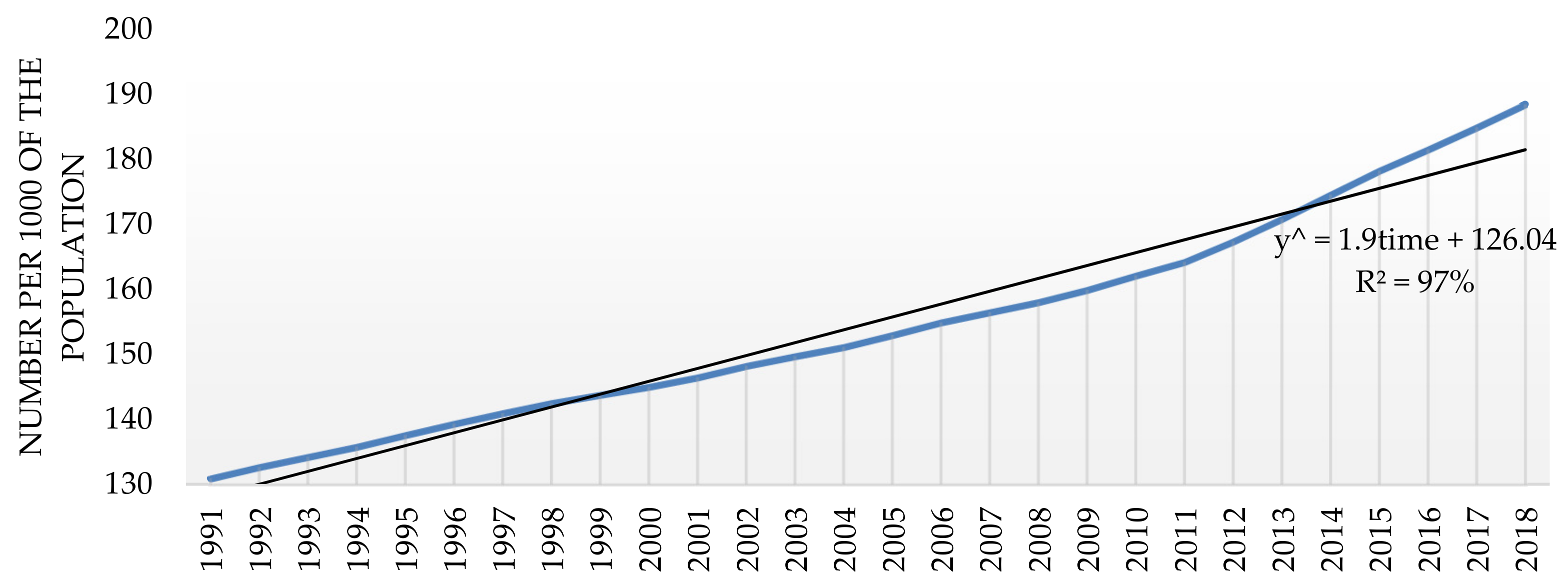
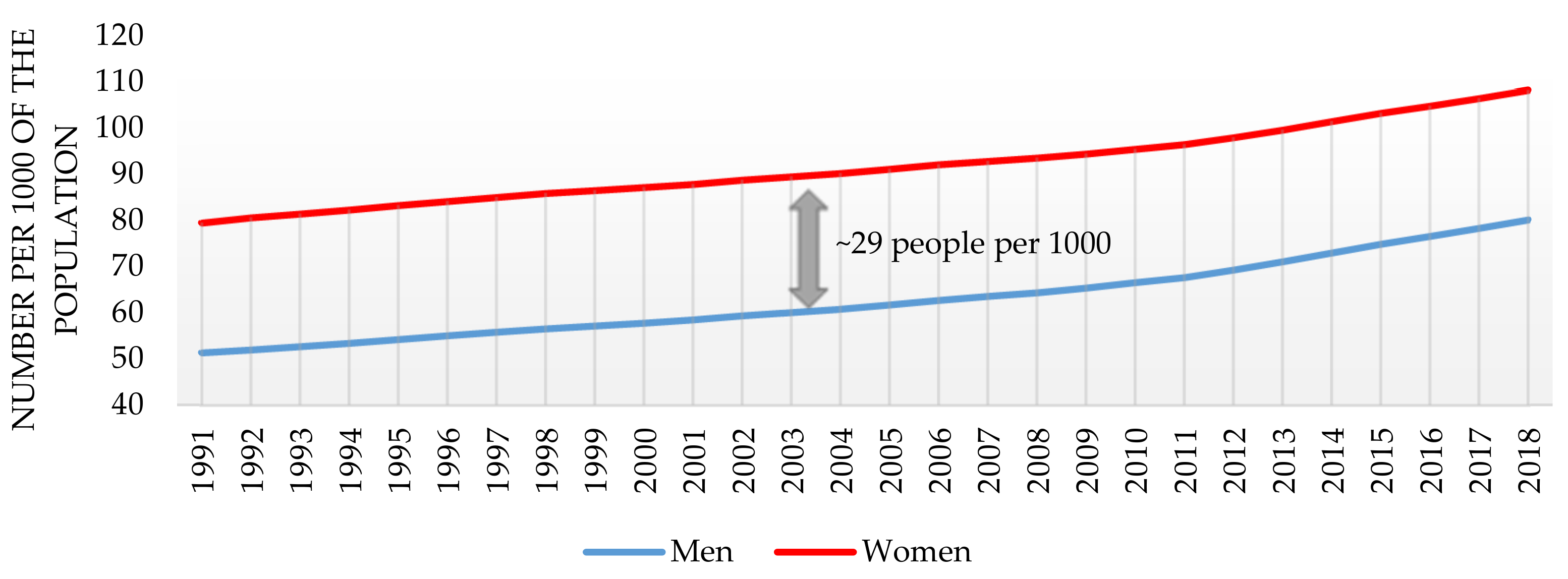
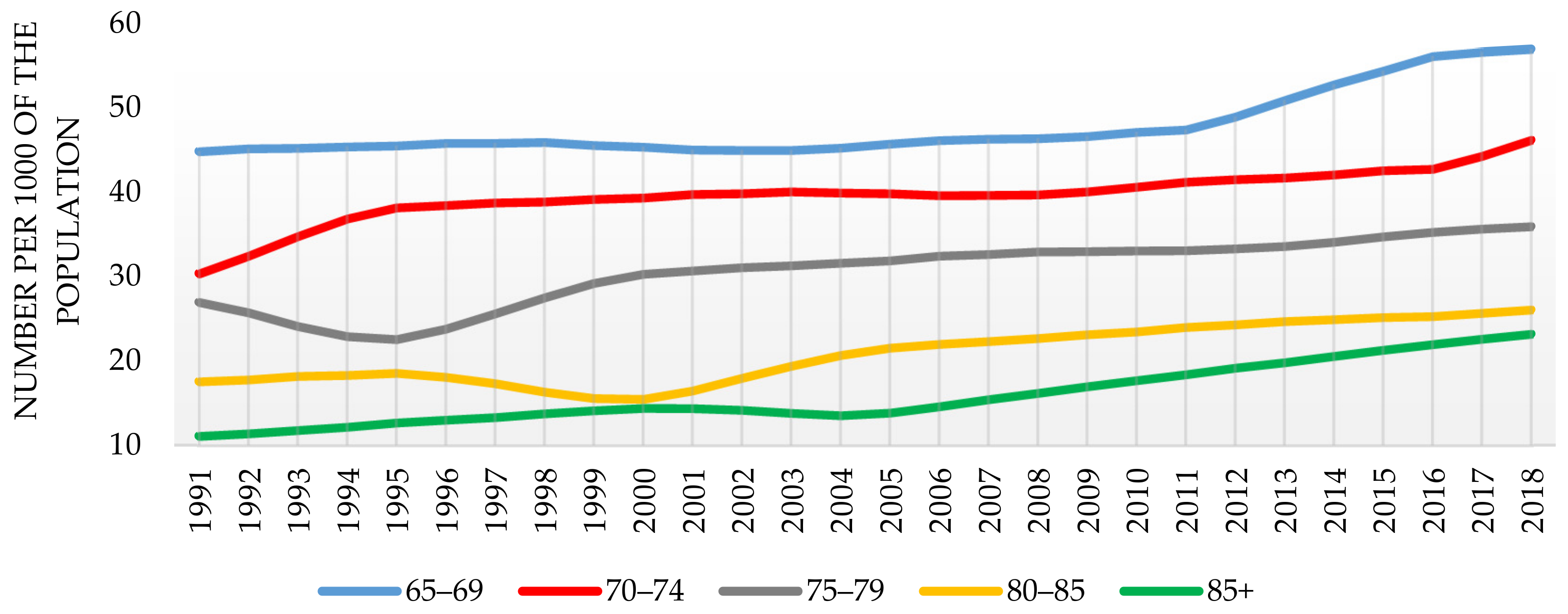


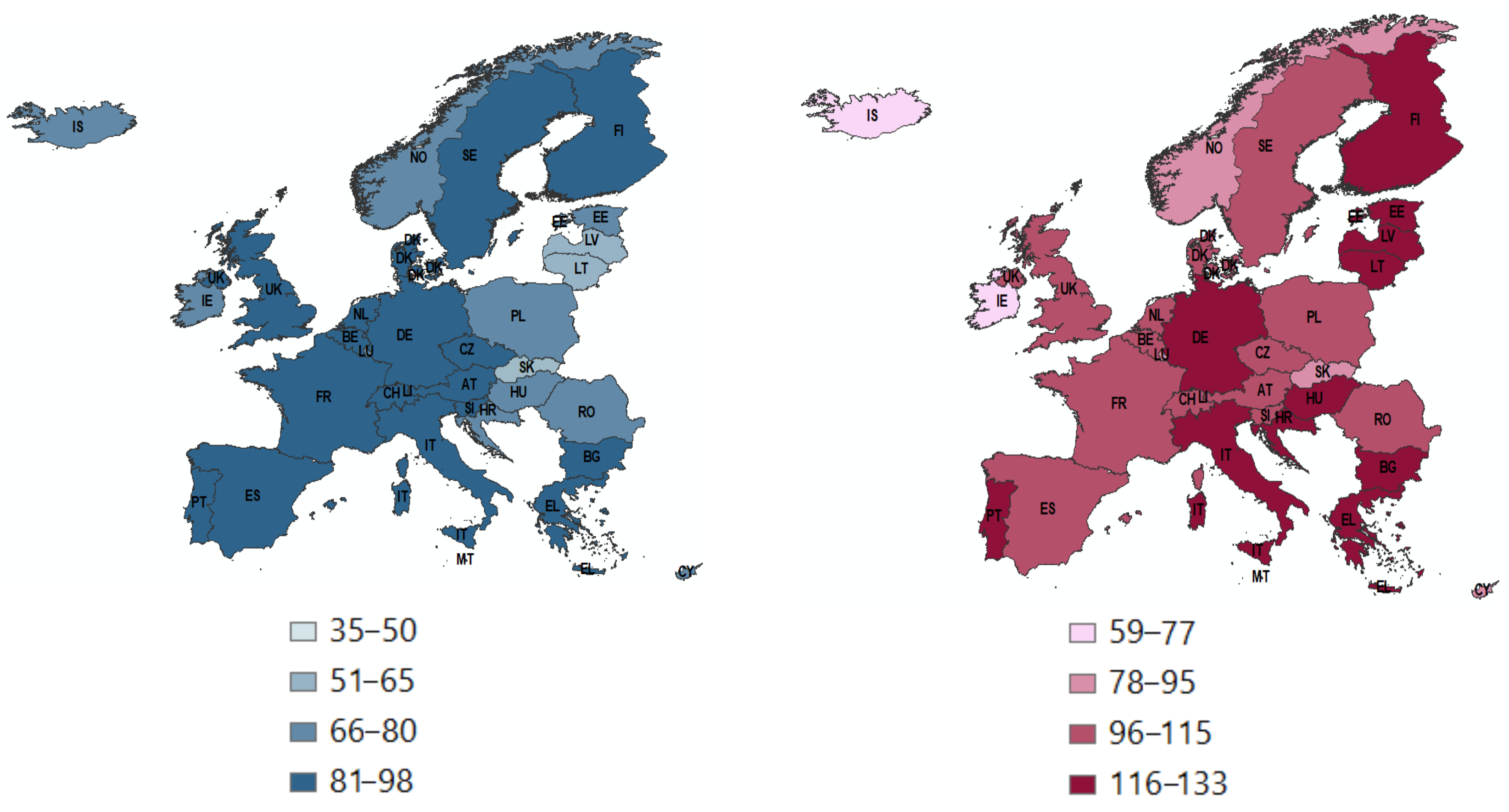
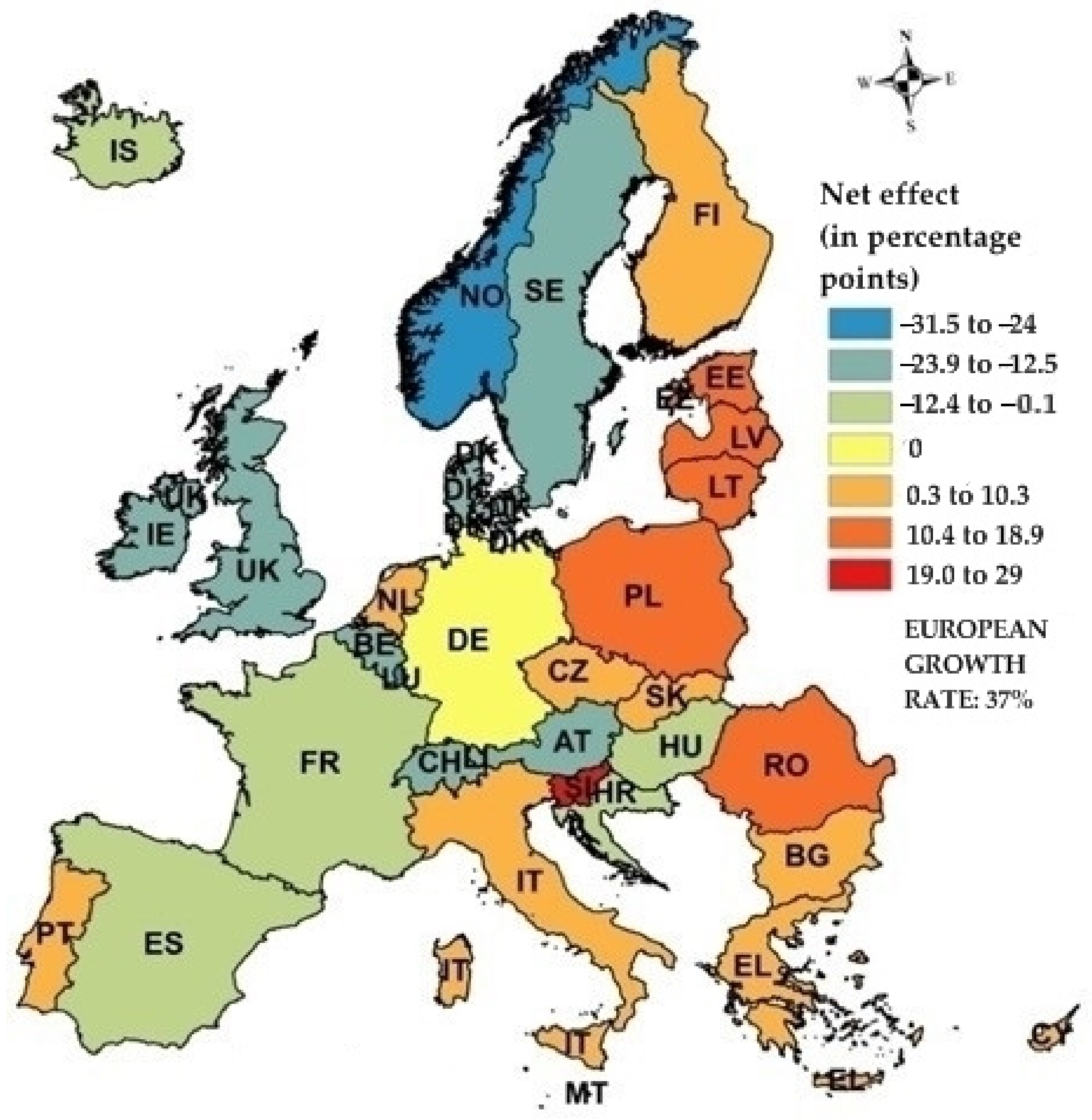

| COUNTRIES | |
|---|---|
| The fastest for txr. ∊ <45.8; 66) | Portugal (45.8), Greece (46), Finland (47.2), Latvia (52), Estonia (52.3), POLAND (52.7), Romania (54.1), Lithuania (55.9), Liechtenstein (59.2), Slovenia (59.3), Malta (66) |
| Fast for txr. ∊ <25.6; 45.8) | Cyprus (44.2), Bulgaria (44.2), the Czech Republic (43), Slovakia (41), Italy (40.4), the Netherlands (39.6), Germany (37), France (34.8), Spain (34.2), Hungary (33.9), Croatia (33.3), Iceland (31.9) |
| Moderate for txr. ∊ <10.8; 25.6) | Sweden (13.6), the United Kingdom (16.1), Ireland (21.6), Belgium (22.7), Denmark (22.9), Austria (23.6), Switzerland (24.4) |
| The slowest for txr.∊ <5.4; 10.8) | Norway (5.4) and Luxembourg (10.4) |
| EUROPEAN GROWTH RATE (tx..): 37 | |
| Country | NEF | SEF | GEF | Country | NEF | SEF | GEF |
|---|---|---|---|---|---|---|---|
| NO | −31.5 | −2.7 | −28.8 | IT | 3.4 | −8.5 | 11.9 |
| LU | −26.5 | −9.2 | −17.4 | SK | 4 | −10.6 | 14.6 |
| SE | −23.4 | −3 | −20.4 | CZ | 6 | −10.1 | 16.1 |
| UK | −20.9 | −5 | −15.8 | BG | 7.2 | −9.9 | 17.1 |
| IE | −15.3 | −5.9 | −9.5 | CY | 7.2 | −6.7 | 13.9 |
| BE | −14.3 | −7.4 | −6.9 | PT | 8.8 | −7.8 | 16.5 |
| DK | −14 | −5 | −9 | EL | 9 | −8 | 17 |
| AT | −13.3 | −8.5 | −4.8 | FI | 10.3 | −7.5 | 17.8 |
| CH | −12.5 | −5.9 | −6.6 | LV | 15 | −14.2 | 29.2 |
| IS | −5 | −4.4 | −0.6 | EE | 15.4 | −13.6 | 29 |
| HR | −3.6 | −10.1 | 6.5 | PL | 15.7 | −11.2 | 26.8 |
| HU | −3 | −10.1 | 7.1 | RO | 17.2 | −11.8 | 28.9 |
| ES | −2.8 | −6.2 | 3.4 | LT | 18.9 | −12.5 | 31.4 |
| FR | −2.1 | −6.7 | 4.5 | LI | 22.3 | −6.7 | 28.9 |
| DE | 0.004 | −9.68 | 9.69 | SI | 22.4 | −12.1 | 34.5 |
| NL | 2.6 | −6.3 | 8.9 | MT | 29 | −6.5 | 35.6 |
| Country | NEF | SEF | 65–69 | 70–74 | 75–79 | 80–84 | 85+ | |||||
| M | W | M | W | M | W | M | W | M | W | |||
| NO | −31.55 | −2.70 | −1.29 | −3.88 | 1.40 | −1.14 | 0.75 | −2.66 | 1.60 | −1.07 | 2.54 | 1.04 |
| LU | −26.53 | −9.15 | −1.64 | −4.93 | 0.91 | −1.82 | 0.19 | −3.44 | 0.98 | −1.74 | 1.69 | 0.64 |
| PL | 15.69 | −11.15 | −1.78 | −5.83 | 0.88 | −2.39 | 0.33 | −3.56 | 0.85 | −1.69 | 1.43 | 0.62 |
| AT | −13.33 | −8.49 | −1.56 | −4.89 | 0.71 | −1.93 | 0.41 | −3.25 | 1.04 | −1.62 | 1.88 | 0.72 |
| SI | 22.36 | −12.10 | −1.75 | −5.89 | 0.67 | −2.38 | 0.11 | −3.65 | 0.69 | −1.84 | 1.33 | 0.62 |
| MT | 29.03 | −6.54 | −1.58 | −5.14 | 1.41 | −1.70 | 0.69 | −2.72 | 1.25 | −1.11 | 1.79 | 0.57 |
| Country | NEF | GEF | 65–69 | 70–74 | 75–79 | 80–84 | 85+ | |||||
| M | W | M | W | M | W | M | W | M | W | |||
| NO | −31.55 | −28.85 | −1.35 | −1.19 | −3.13 | −4.03 | −3.80 | −4.14 | −3.19 | −3.91 | −2.09 | −2.02 |
| LU | −26.53 | −17.38 | 0.27 | −3.16 | −1.49 | −3.59 | −2.15 | −3.23 | −0.99 | −2.16 | −0.27 | −0.62 |
| PL | 15.69 | 26.84 | 4.64 | 6.37 | 1.40 | 4.39 | −0.11 | 2.84 | 0.03 | 3.02 | 0.39 | 3.87 |
| AT | −13.33 | −4.83 | −0.16 | −3.92 | 1.05 | −0.73 | 1.66 | 0.43 | −1.03 | −2.39 | −0.27 | 0.52 |
| SI | 22.36 | 34.45 | 6.63 | 2.73 | 4.51 | 5.77 | 1.95 | 3.42 | 1.01 | 3.10 | 0.72 | 4.61 |
| MT | 29.03 | 35.57 | 5.59 | 6.70 | 4.73 | 7.27 | 0.74 | 3.79 | 0.42 | 3.41 | −0.01 | 2.92 |
© 2019 by the authors. Licensee MDPI, Basel, Switzerland. This article is an open access article distributed under the terms and conditions of the Creative Commons Attribution (CC BY) license (http://creativecommons.org/licenses/by/4.0/).
Share and Cite
Antczak, E.; Lewandowska-Gwarda, K. How Fast Is Europe Getting Old? Analysis of Dynamics Applying the Spatial Shift–Share Approach. Sustainability 2019, 11, 5661. https://doi.org/10.3390/su11205661
Antczak E, Lewandowska-Gwarda K. How Fast Is Europe Getting Old? Analysis of Dynamics Applying the Spatial Shift–Share Approach. Sustainability. 2019; 11(20):5661. https://doi.org/10.3390/su11205661
Chicago/Turabian StyleAntczak, Elżbieta, and Karolina Lewandowska-Gwarda. 2019. "How Fast Is Europe Getting Old? Analysis of Dynamics Applying the Spatial Shift–Share Approach" Sustainability 11, no. 20: 5661. https://doi.org/10.3390/su11205661
APA StyleAntczak, E., & Lewandowska-Gwarda, K. (2019). How Fast Is Europe Getting Old? Analysis of Dynamics Applying the Spatial Shift–Share Approach. Sustainability, 11(20), 5661. https://doi.org/10.3390/su11205661






